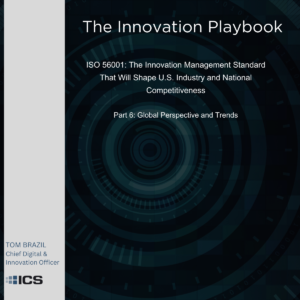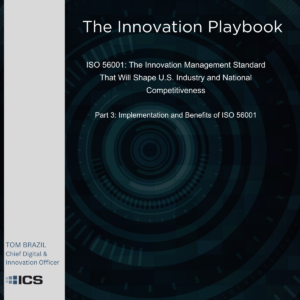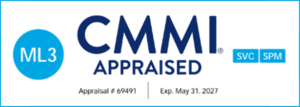In previous discussions, we explored what ISO 56001 is, how it’s structured, and the process for certification and compliance. By now, it’s clear that ISO 56001 is not just about innovation for the sake of innovation—it’s about managing it strategically.
But here’s where the conversation shifts from compliance to competitive advantage.
For organizations in defense, aerospace, healthcare, technology, and beyond, innovation isn’t just a buzzword, it’s a mission-critical function. Whether it’s AI for cybersecurity, advanced materials for defense, or next-gen pharmaceuticals, innovation must be integrated into business strategy, championed by leadership, and measured for impact.
That’s exactly what we’ll explore in this installment:
- How ISO 56001 fosters a culture of innovation
- The role of leadership in structured innovation
- How innovation aligns with business strategy
- The importance of measuring innovation success
Let’s dive in.
Creating a Culture of Innovation with ISO 56001
Many organizations struggle to embed innovation into their DNA. It’s not enough to encourage creativity—there must be a system to support, reward, and sustain it.
ISO 56001 ensures that innovation isn’t left to chance or a select few “creative minds” in R&D. Instead, it provides a framework where everyone—from engineers to finance teams—can contribute ideas, validate them, and bring them to life.
What Does an Innovation Culture Look Like?
In an ISO 56001-driven organization, innovation isn’t just a side project—it’s an everyday function of the business. This means:
- Employees feel safe to experiment and take calculated risks.
- There are mechanisms for capturing and evaluating new ideas.
- Leadership provides time, funding, and recognition for innovation efforts.
- Failure is treated as a learning opportunity, not a career-ending mistake.
This is where U.S. industry and government agencies can take cues from high-performing innovation cultures. Silicon Valley tech firms, major defense contractors, and pharmaceutical giants all recognize that a structured innovation culture leads to better outcomes, faster breakthroughs, and higher returns on investment.
📌 Example: ICS took a structured and intentional approach to fostering a culture of innovation, recognizing it as the most challenging yet critical element of an Agile Innovation Management System (AIMS). We asserted that a culture that supports innovation must start at the top, with leadership setting the tone, aligning the organization’s values with innovation goals, and actively removing barriers to experimentation and creativity. Our AIMS emphasizes the need for Innovation Leaders, Champions, and Creative Geniuses—each playing distinct roles in guiding, supporting, and executing innovation initiatives. A key challenge highlighted is the traditional managerial focus on efficiency and predictability, which often conflicts with the inherent risk and variability of innovation. To counteract this, we advocate for structured engagement, intentional workforce development, and training in the common language of innovation, ensuring that all levels of the organization—from executives to frontline employees—understand and contribute to the innovation process. The culture is reinforced through a combination of leadership commitment, reward mechanisms, and a balance between operational excellence and creative exploration, ensuring that innovation becomes a sustainable, repeatable practice rather than an ad hoc effort.
The Role of Leadership in Driving Innovation
Even the most well-designed innovation framework will fail without leadership buy-in. ISO 56001 requires top management to take accountability for innovation—not just as an R&D initiative but as a core driver of business success.
What Leadership Must Do Under ISO 56001
- Define an Innovation Vision
- Executives must establish a clear innovation policy that aligns with corporate goals.
- Integrate Innovation into Decision-Making
- Innovation efforts must be aligned with business strategy and investment priorities.
- Allocate Resources for Innovation
- Leaders must provide dedicated time, funding, and support for innovation initiatives.
- Remove Organizational Barriers
- Bureaucracy and risk-averse cultures kill innovation. Leaders must break down silos and encourage cross-functional collaboration.
- Measure and Reward Innovation Success
- Employees and teams must see real incentives for driving innovation forward.
Why Leadership Matters in U.S. Industry and Government
For U.S. companies and federal agencies, leadership commitment is especially critical in high-stakes innovation environments like defense and energy. Without strong leadership, AI-driven defense systems, cybersecurity advancements, and next-gen manufacturing breakthroughs stall in bureaucratic bottlenecks.
📌 Example: Tesla’s rapid EV innovation isn’t just about great engineers—it’s because leadership prioritizes R&D investment and isn’t afraid to disrupt traditional industry models. ISO 56001 ensures that organizations don’t just rely on a visionary CEO but have a leadership system that institutionalizes innovation across the enterprise.
Aligning Innovation with Business Strategy
One of the biggest failures in corporate innovation is the disconnect between business objectives and innovation initiatives. Too often, companies invest in shiny new technologies without a clear roadmap for value creation.
ISO 56001 solves this by requiring organizations to align innovation efforts with overall corporate strategy. This means:
- Innovation must be linked to long-term business goals—not just short-term experimentation.
- Organizations must define innovation portfolios that balance low-risk incremental improvements with high-risk, high-reward breakthroughs.
- There must be a governance structure that ensures innovation funding is aligned with strategic priorities.
How This Works in Practice
Aligning innovation efforts with business strategy is a core principle of an Agile Innovation Management System. ICS emphasizes that innovation should not be a random pursuit of ideas but a structured effort that directly contributes to achieving business objectives. This alignment ensures that resources are allocated effectively, risk is managed, and innovation efforts generate real value for the organization.
Key Steps for Aligning Innovation with Business Strategy
- Define Strategic Intent Clearly
Innovation must start with a well-defined strategic intent, derived from the organization’s vision and long-term goals. The book highlights that strategy is a plan to achieve the vision, but it must be broken down into measurable and executable strategic objectives. These objectives serve as the foundation for selecting, prioritizing, and managing innovation initiatives. - Translate Strategy into Measurable Strategic Objectives
Strategic objectives should be specific, measurable, and actionable. For example, if a company’s strategy includes “expanding into new markets,” the corresponding innovation objectives might involve developing new products, exploring emerging technologies, or forming strategic partnerships. These objectives then guide the innovation portfolio. - Ensure Portfolio Alignment with Strategy
The innovation portfolio must reflect the organization’s strategic priorities. To do this, ICS uses an approach that evaluates all innovation ideas and projects based on their alignment with strategic objectives. The Elovator Algorithm ensures that portfolio decisions are based on strategic fit, risk management, and the desired balance of short-, medium-, and long-term innovation efforts. - Use a Dynamic Portfolio Approach to Adapt to Change
Given the pace of technological and market changes, strategic objectives and their weightings may need to shift. ICS incorporates real-time portfolio pivoting, ensuring that when leadership updates strategic priorities, the innovation portfolio is automatically adjusted to maintain alignment. This prevents wasted resources on outdated projects and ensures that innovation efforts stay relevant. - Create Feedback Loops Between Strategy and Innovation
Innovation must be a continuous, data-driven process, not a one-time initiative. By integrating metrics, performance assessments, and leadership reviews, the organization ensures that innovation efforts remain strategically aligned. Quarterly and annual strategic planning sessions, as well as continuous monitoring of market trends and technology landscapes, inform adjustments to innovation efforts. - Leverage the Right Roles and Culture for Strategic Execution
Alignment requires leaders, champions, and teams who understand both the business strategy and the innovation process. The Innovation Council (IC) plays a key role in ensuring that every innovation project aligns with corporate priorities. Additionally, creating a culture that supports strategic innovation—where employees understand how their contributions fit into the larger vision—enhances engagement and execution. - Integrate Innovation into Business Operations and Decision-Making
Innovation should not be siloed but embedded in the core business processes. ICS integrates innovation management with quality management (ISO 9001), business performance monitoring, and operational workflows to ensure that innovation is not just an R&D function but a driver of overall business success.
The Result: A Systematic and Agile Approach
By aligning innovation efforts with business strategy using structured processes, real-time feedback loops, and dynamic portfolio management, organizations ensure that innovation is not just about creativity but about delivering meaningful business value. This approach enables companies to adapt, compete, and thrive in an environment of continuous change while ensuring that innovation investments support strategic growth and long-term success.
Measuring and Tracking Innovation Performance
A common misconception about innovation is that it’s intangible and difficult to measure. ISO 56001 challenges this mindset by requiring organizations to establish clear, quantifiable metrics for innovation performance.
Key Innovation KPIs Under ISO 56001 could include:
- Time-to-market for new products or services
- Percentage of revenue from new innovations
- Return on investment (ROI) for R&D spending
- Success rate of innovation projects
- Employee participation in innovation initiatives
- Customer satisfaction with new solutions
Organizations must not only track these metrics but continuously refine their innovation processes based on performance insights.
Example from ICS
ICS’s approach to innovation metrics is deeply rooted in its commitment to fostering a dynamic, results-driven culture. These metrics serve not merely as data points but as the guiding framework that shapes decision-making, project progression, and the overall effectiveness of the innovation ecosystem.
At the heart of ICS’s measurement strategy is the belief that innovation must be both encouraged and evaluated in a structured manner. The organization continuously tracks the number of ideas submitted, not just as a tally but as an indication of engagement—proof that employees are actively participating in shaping the future. By monitoring how many of these ideas transition into viable projects, ICS ensures that enthusiasm is not just a fleeting burst of creativity but an engine that drives tangible progress.
Time is another critical dimension in this evaluation. Our organization carefully monitors how long projects spend in each stage of development, recognizing that while breakthroughs cannot be rushed, stagnation is a sign of inefficiency. To maintain momentum, ICS evaluates project duration and ensures that resources are allocated to the right initiatives at the right time. This balance of patience and urgency is essential to fostering an innovation pipeline that is both sustainable and productive.
Perhaps one of the most distinctive aspects of ICS’s approach is its Functional Value of Innovation (FVOI) framework. This algorithmic assessment does more than just validate the financial viability of a project—it evaluates its functional impact, ensuring that each initiative contributes meaningfully to the company’s broader goals. By doing so, ICS avoids the common pitfall of chasing innovation for its own sake and instead focuses on fostering advancements that deliver true, measurable value.
Our organization’s commitment to strategic alignment is evident in how it evaluates innovation projects. ICS does not leave selection to chance; instead, it employs structured evaluation mechanisms like the Elovator Algorithm and the Gauntlet Competition to ensure that investments align with long-term corporate priorities. These tools help decision-makers balance risk and reward, ensuring that their portfolio is not just filled with promising ideas but with ideas that have a clear path to success.
Infrastructure plays an equally important role in ICS’s innovation system. Our organization closely monitors the cost-effectiveness of our IT environment, comparing cloud-based resources with on-premises solutions to ensure that the technological backbone of innovation remains both efficient and scalable. This level of scrutiny extends beyond financials—it is about ensuring that innovators have seamless access to the tools and platforms they need to bring their ideas to life.
Ultimately, ICS does not believe in passive measurement. Metrics are not just numbers; they are signals—guiding leaders toward better decisions, helping teams refine their strategies, and ensuring that the company’s innovation efforts are always moving forward with purpose. By adhering to SMART (Specific, Measurable, Achievable, Realistic, Time-related) principles, ICS ensures that every measurement serves a purpose, every assessment drives improvement, and every innovation effort contributes to a future built on continuous progress.
Why This Matters for U.S. Industry & Government
For industries where innovation cycles are long and costly—such as defense, energy, and infrastructure—measuring ROI is crucial. The federal government, in particular, must ensure that taxpayer-funded innovation delivers real economic and national security benefits.
Why U.S. Organizations Must Take ISO 56001 Seriously
Innovation isn’t just about creativity—it’s about execution. Companies and government agencies that implement ISO 56001 will:
- Foster a culture of sustainable innovation rather than sporadic breakthroughs.
- Ensure leadership drives strategic, high-impact innovation rather than unfocused R&D.
- Align innovation with long-term business goals, regulatory frameworks, and market needs.
- Measure and optimize innovation performance continuously.
As China, Germany, and South Korea double down on structured innovation systems, U.S. industry and government cannot afford to take a passive approach. ISO 56001 provides the blueprint for ensuring the U.S. remains the global leader in technological advancement and industrial innovation.
What’s Next? The Global Perspective on ISO 56001
Next week, we’ll take a global look at ISO 56001 adoption and explore:
- How other nations and industries are embedding structured innovation into their economies.
- How ISO 56001 supports emerging technologies like AI, blockchain, and green energy.
- What future trends will shape innovation management over the next decade.
Are U.S. businesses and agencies ready to lead in structured innovation? Let’s discuss in the comments!
Follow this series for insights on how ISO 56001 is shaping the future of U.S. innovation and competitiveness.







